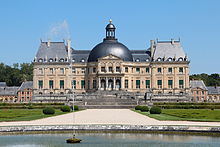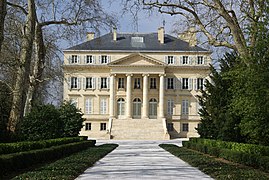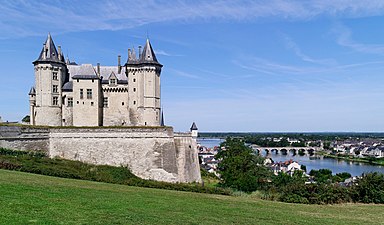Château

A château (French pronunciation: [ʃɑto]; plural: châteaux) is a manor house or residence of the lord of the manor, or a fine country house of nobility or gentry, with or without fortifications, originally, and still most frequently, in French-speaking regions.
Nowadays, a château may be any stately residence built in a French style; the term is additionally often used for a winegrower's estate, especially in the Bordeaux region of France.[1]
Definition

The word château is a French word that has entered the English language, where its meaning is more specific than it is in French. The French word château denotes buildings as diverse as a medieval fortress, a Renaissance palace and a fine 19th-century country house. Care should therefore be taken when translating the French word château into English, noting the nature of the building in question. Most French châteaux are "palaces" or fine "country houses" rather than "castles", and for these, the word "château" is appropriate in English. Sometimes the word "palace" is more appropriate. To give an outstanding example, the Château de Versailles, also called in French le palais de Versailles, is so-called because it was located in the countryside when it was built, but it does not bear any resemblance to a castle, so it is usually known in English as the Palace of Versailles. When clarification is needed in French, the term château fort is used to describe a fortified castle, such as the Château fort de Roquetaillade.
The urban counterpart of a château is a palais in French, which is usually applied only to very grand residences in a city. This usage is again different from that of the term "palace" in English, where there is no requirement that a palace must be in a city, but the word palais is rarely used for buildings other than the grandest royal residences. The term hôtel particulier is used in French for an urban "private house" of a grand sort.[2]
Concept
A château is a "power house", as Sir
A château was historically supported by its terres (lands), composing a
In the city of Paris, the
In the United States, the word château took root selectively – in the
French châteaux—particular regions
Bordeaux region
There are many estates with true châteaux on them in the Bordeaux wine regions, but it is customary for any wine-producing estate since the 19th century, no matter how humble, to prefix its name with "Château". This term became the default way of designating an estate in Bordeaux, in the same way that Domaine did in Burgundy. Both Château and Domaine are aristocratic in implication, but Bordeaux had a better claim to the association: nobles had owned Bordeaux's best vineyards for centuries. Most of Burgundy's best vineyards, in contrast, had been owned by the Church. The term Château became a permanent verbal fixture in Bordeaux, and it was emulated in other French regions and outside France.[8]
-
Château Cheval-Blanc
The winery denomination Château is now protected by French law, and confirmed in 1981 by European Union law,[9] as "traditional appellation". The term Château may be used only if two conditions are fulfilled:
- The wine concerned have to be made exclusively from grapes harvested from wine belonging to that vineyard,
- The wine-making process was carried out there.
Loire Valley

The
French châteaux—selected examples
Château de Chenonceau

The Château de Chenonceau is a French château spanning the river Cher, near the small village of Chenonceaux in the Indre-et-Loire department of the Loire Valley in France. It is one of the best-known châteaux of the Loire Valley. The estate of Chenonceau is first mentioned in writing in the 11th century. The current château was built in 1514–1522 on the foundations of an old mill and was later extended to span the river. The bridge over the river was built from 1556 to 1559 to designs by the French Renaissance architect Philibert de l'Orme, and the gallery on the bridge, built from 1570 to 1576 to designs by Jean Bullant.
Château de Dampierre-en-Yvelines

Built by
Château de Montsoreau
The Château de Montsoreau is the only Château of the Loire Valley to have been built directly in the Loire riverbed. It is also one of the first example of a renaissance architecture in France.[13] Montsoreau was built in 1453 by Jean II de Chambes (first counsellor of Charles VII of France and ambassador of France to Venice and to Turkey) by order of the king soon after the end of the Hundred's years war. The French dramatist Alexandre Dumas made the château de Montsoreau world famous with his trilogy on the French Wars of Religion of which the lady of Monsoreau is the second volume.[14]

Château de Vaux-le-Vicomte
The Château de
Château de Versailles
The
Gallery
See also
References
- ^ "Dictionary.com". Archived from the original on 4 March 2016. Retrieved 13 April 2014.
- ISBN 978-0-470-63725-8. Archivedfrom the original on 29 November 2023. Retrieved 6 November 2015.
- ISBN 978-0-674-83040-0. Archivedfrom the original on 29 November 2023. Retrieved 6 November 2015.
- ISBN 978-0-313-33683-6. Archivedfrom the original on 29 November 2023. Retrieved 6 November 2015.
- ISBN 978-0-7546-5789-7. Archivedfrom the original on 29 November 2023. Retrieved 6 November 2015.
- ISBN 978-0-7645-8770-2. Archivedfrom the original on 29 November 2023. Retrieved 6 November 2015.
- ISBN 978-1-118-10169-8. Archivedfrom the original on 29 November 2023. Retrieved 6 November 2015.
- ^ "Commission Regulation (EEC) No 997/81 of 26 March 1981 laying down detailed rules for the description and presentation of wines and grape musts, Article 5". Archived from the original on 28 December 2023. Retrieved 24 May 2020.
- ISBN 978-1-85418-493-1. Archivedfrom the original on 29 November 2023. Retrieved 6 November 2015.
- ^ Ouvert au public (in French). Editions de la Caisse nationale des monuments historiques et des sites. 1983. p. 111. Archived from the original on 29 November 2023. Retrieved 6 November 2015.
- ISBN 978-1-870673-55-6. Archivedfrom the original on 24 December 2023. Retrieved 6 November 2015.
- ^ Litoux, Emmanuel (2003). Congrès Archéologique de France. Société Française d'Archéologie. p. 255.
- ^ "La Dame de Monsoreau" (in French). dumaspere.com. 1998. Archived from the original on 11 August 2017. Retrieved 18 March 2019.
- ISBN 978-0-313-31902-0. Archivedfrom the original on 29 November 2023. Retrieved 6 November 2015.
External links
- . Encyclopædia Britannica. Vol. 5 (11th ed.). 1911.

















